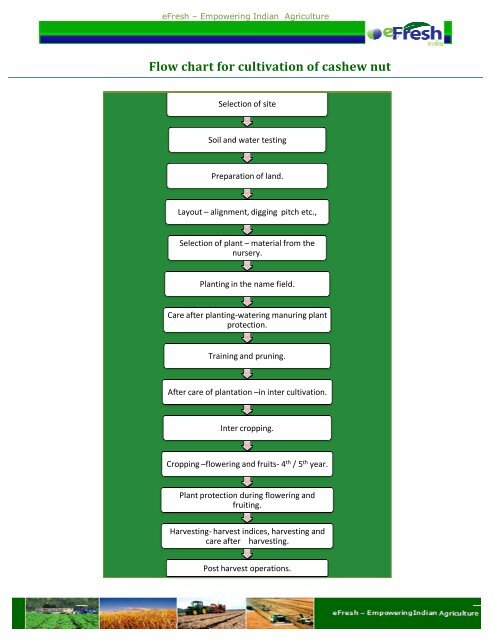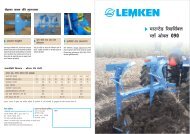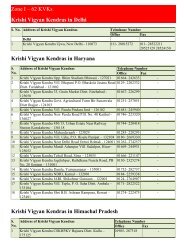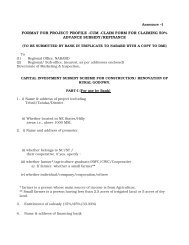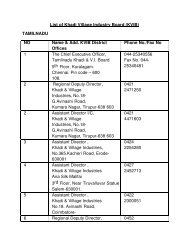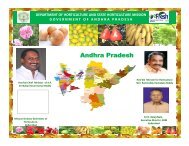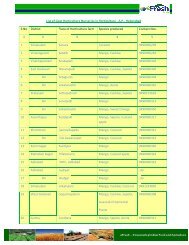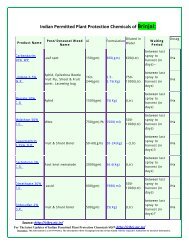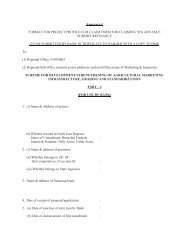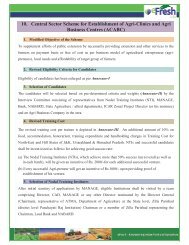Flow chart for cultivation of cashew nut - Efresh India
Flow chart for cultivation of cashew nut - Efresh India
Flow chart for cultivation of cashew nut - Efresh India
Create successful ePaper yourself
Turn your PDF publications into a flip-book with our unique Google optimized e-Paper software.
eFresh – Empowering <strong>India</strong>n Agriculture<br />
<strong>Flow</strong> <strong>chart</strong> <strong>for</strong> <strong>cultivation</strong> <strong>of</strong> <strong>cashew</strong> <strong>nut</strong><br />
Selection <strong>of</strong> site<br />
Soil and water testing<br />
Preparation <strong>of</strong> land.<br />
Layout – alignment, digging pitch etc.,<br />
Selection <strong>of</strong> plant – material from the<br />
nursery.<br />
Planting in the name field.<br />
Care after planting-watering manuring plant<br />
protection.<br />
Training and pruning.<br />
After care <strong>of</strong> plantation –in inter <strong>cultivation</strong>.<br />
Inter cropping.<br />
Cropping –flowering and fruits- 4 th / 5 th year.<br />
Plant protection during flowering and<br />
fruiting.<br />
Harvesting- harvest indices, harvesting and<br />
care after harvesting.<br />
Post harvest operations.
eFresh – Empowering <strong>India</strong>n Agriculture<br />
• Selection <strong>of</strong> site<br />
• Soil and water testing<br />
• Preparation <strong>of</strong> land.<br />
• Layout – alignment, digging pitch etc.,<br />
• Selection <strong>of</strong> plant – material from the nursery.<br />
• Planting in the name field.<br />
• Care after planting-watering manuring plant protection.<br />
• Training and pruning.<br />
• After care <strong>of</strong> plantation –in inter <strong>cultivation</strong>.<br />
• Inter cropping.<br />
• Cropping –flowering and fruits- 4 th / 5 th year.<br />
• Plant protection during flowering and fruiting.<br />
• Harvesting- harvest indices, harvesting and care after harvesting.<br />
• Post harvest operations.<br />
Note: Package may differ depending upon the type <strong>of</strong> orchard crop and agro climatic conditions
eFresh – Empowering <strong>India</strong>n Agriculture<br />
Brief in right in to each <strong>of</strong> the above operations<br />
1. Selection <strong>of</strong> site:<br />
• Tropical areas are best, select <strong>for</strong>t free areas.<br />
• Select deep well drained sandy loams.<br />
• Acid areas reclines varies during flowering and fruiting.<br />
2. Soil and water testing:<br />
• To know the suitability <strong>of</strong> soil and its fertility p H , whether nature <strong>of</strong> soil and soil depth<br />
meets the crop requirements.<br />
• Water testing is essential to know quality <strong>of</strong> water on use amendments to suit <strong>cashew</strong> <strong>nut</strong><br />
crop.<br />
3. Preparation <strong>of</strong> land:<br />
• Remove all the vegetation, stubbles and roots.<br />
• Plough the land 3-4 times in all directions depending on the nature <strong>of</strong> the soil.<br />
• Level the land with a gentle slope <strong>for</strong> drainage.<br />
4. Layout –alignment, digging <strong>of</strong> pits etc:<br />
• Layout the field is square system <strong>of</strong> planting with a spacing <strong>of</strong> 5-8 m on either side<br />
• Dig pits <strong>of</strong> size 60cm 3 to 100 cm<br />
• Expose the pits <strong>for</strong> a couple <strong>of</strong> weeks <strong>for</strong> weathering.<br />
• Then refill the pits with top soil mixed with 5kg FYM on compost and rock phosphate<br />
(200g)<br />
• Allow the soil in the pits to settle by watering.<br />
5. Selection <strong>of</strong> planting material <strong>for</strong> the nursery:<br />
• Select s<strong>of</strong>t wood grafts <strong>for</strong> planting.<br />
• Select disease and insect free, vigorously growing healthy grafts <strong>of</strong> 1-1 ½ years age.
eFresh – Empowering <strong>India</strong>n Agriculture<br />
6. Planting in the main field:<br />
• At the start <strong>of</strong> monsoon rains (June-July) take up planting the grafts in the main field.<br />
• Cut open the poly bag without disturbing the ball <strong>of</strong> earth and root system and set the plant<br />
in the hole, scooped out in the centre <strong>of</strong> the pit.<br />
• Press the soil around the plant to remove air from the soil.<br />
• Make a basis at distance <strong>of</strong> 30 cm from in plant around the plant <strong>for</strong> watering.<br />
• Water the plant immediately after planning.<br />
• Provided support with a bamboo stake.<br />
7. Care after planting-watering, manuring and plant protection:<br />
• Water the newly set plants frequently, particularly during only periods <strong>for</strong> 2-3 summers.<br />
• Apply chemical fertilizers, particularly nitrogen at by monthly intervals to speed up<br />
growth.<br />
• Take appropriate plant protection measures against sucking pests.<br />
8. Training and pruning:<br />
• Remove the sprouts on the root stock portion <strong>of</strong> the grafts.<br />
• Commence the training <strong>of</strong> plants from second year <strong>of</strong> planning and complete by 4 th year.<br />
• Prune the lower hanging branches, criss-crossing branches, water suckers, dried and<br />
diseases things and old panickle plants.<br />
9. After care <strong>of</strong> plantation –inter <strong>cultivation</strong>:<br />
• Plough the field frequently in the young gardens to chuck the weeds, to improve<br />
infiltration <strong>of</strong> water during rains.<br />
• In the bearing gardens plough the field at least twice or thrice during the rains – once at the<br />
start <strong>of</strong> the rains, next in the middle <strong>of</strong> rainy season and next at the end <strong>of</strong> the rainy season.<br />
10. Inter cropping:<br />
• Grow lagumes as inter crops.<br />
• In coastal areas, casuarinas, coco<strong>nut</strong> and pineapple may be grown as inter crops.
eFresh – Empowering <strong>India</strong>n Agriculture<br />
11. Cropping –flowering and fruiting<br />
• <strong>Flow</strong>ering in <strong>cashew</strong> grafts starts from 3rd year. But better to take crop from 5 th year – till<br />
then deblossom the trees.<br />
• <strong>Flow</strong>ering occurs during January to March.<br />
12. Plant protection during flowering and fruiting:<br />
• Control the tea-mosquito bug, a serious pest on new flushes and inflorescences.<br />
• Control other sucking pests like thrips, panicle feeders, shoot tip borers, apply and <strong>nut</strong><br />
borers etc., promptly.<br />
• In bearing orchards (more than 10 years ) stem-borers in a serious pest. Keep the orchard<br />
clean <strong>for</strong> management <strong>of</strong> the pest.<br />
13. Harvesting:<br />
• Collect the dropped fruits and separate the <strong>nut</strong>s from the apple.<br />
14. Post –harvest operation:<br />
• Dry the raw <strong>nut</strong>s in open places on hard floors <strong>for</strong> 4-5 days.<br />
• Then pack the raw <strong>nut</strong>s in suitable gunny bags <strong>for</strong> transport assembling centers or<br />
processing units.


